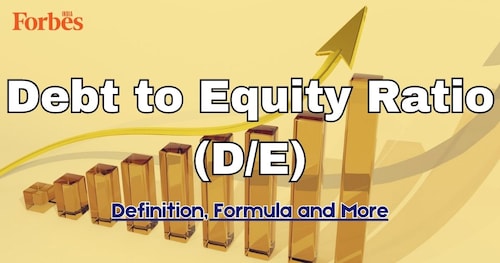Debt to equity ratio (D/E): What is it, formula and calculation
How stable is a company? The debt-to-equity ratio reveals all. Discover this key metric and unlock smarter investment strategies


Have you ever wondered how financially healthy a company is? Probably often if you’re an investor, trader, or even a fan. Look no further than the debt-to-equity ratio. This blog post will help you understand all about this crucial financial metric. We"ll delve into what it means, how it"s calculated, and why it matters for investors and businesses alike.
The debt-to-equity (D/E) ratio, also called the liability-to-equity ratio, is a financial measurement that compares a company"s total liabilities (debt) to its shareholder equity (worth). In simpler terms, it tells you how much a company finances its operations through borrowing (debt) compared to its own invested capital (equity).
The debt-to-equity ratio formula is quite straightforward:
D/E ratio = Total debt / total shareholders" equity
Here"s a breakdown of the components:
Total debt: This represents all the company"s financial obligations, including short-term liabilities (like accounts payable) and long-term liabilities (like loans and bonds).
Total shareholders" equity: This reflects the company"s net worth, essentially the difference between its total assets and total liabilities. It represents the funds contributed by shareholders and retained earnings over time.
By dividing total debt by total shareholders" equity, we get a ratio that indicates the relative weight of debt financing compared to equity financing.
Here"s how to calculate the debt-to-equity ratio:
Gather information: You"ll need the company"s financial statements, precisely the balance sheet. This document lists the company"s assets, liabilities, and shareholders" equity.
Total debt: Locate the liabilities section in the balance sheet. Add up all the debt-related items, such as short-term borrowings, long-term loans, and bonds payable.
Total shareholders" equity: Find the shareholders" equity section on the balance sheet. This section might be further divided into common stock, retained earnings, and additional paid-in capital. Add these components together to get the total shareholders" equity.
Apply the formula: Once you have both values, simply plug them into the D/E ratio formula.
Interpreting a debt-to-equity (D/E) ratio requires considering several factors because no single "perfect" ratio applies universally. D/E ratio can either be on the higher end or low let"s discuss them both:
A higher debt-to-equity ratio (D/E) may suggest a company relies heavily on debt financing. This can be risky if the company struggles to generate enough cash flow to cover its debt obligations (interest payments and loan repayments). However, it"s important to consider the industry context.
A low D/E ratio is generally considered more favourable. This suggests a company finances itself primarily with its own equity (owner"s investment), potentially indicating a more conservative financial approach and lower risk of defaulting on debt.
Let"s take a hypothetical company, ABC Inc. and analyse its financial leverage. Their balance sheet shows Rs. 5 crore in debt and Rs. 3 crore in equity. Calculating their D/E ratio gives us 1.67.
Interpretation: This company relies somewhat on debt (moderate D/E ratio), but a deeper dive is needed. We should compare this ratio to the company’s industry average and analyse other financial metrics for a complete picture.
Here are some of the benefits of calculating liability to equity ratio:
Gauges financial leverage: The D/E ratio shows how a company finances its operations – through debt (borrowed money) or equity (owner"s investment). A lower ratio suggests a conservative approach with more equity, while a higher ratio indicates greater reliance on debt.
Risk assessment for investors: By analysing the D/E ratio, investors can assess the risk associated with investing in a company. A high D/E ratio might signify a higher risk of defaulting on debt obligations if the company struggles financially.
Tax advantages: Interest payments on debt are often tax-deductible, which can improve a company"s bottom line. A D/E analysis can help understand this potential benefit.
The liability-to-equity ratio, while a helpful tool, has some limitations to consider:
Industry dependence: An "ideal" D/E ratio can vary significantly across industries. A high ratio might be acceptable for capital-intensive industries like utilities, whereas a lower ratio might be preferable for service-based industries.
Quality of debt ignored: The D/E ratio treats all debt equally, regardless of its interest rate or repayment terms. Higher-interest debt can significantly increase the financial burden compared to lower-interest debt.
Profitability not considered: The D/E ratio doesn"t take into account a company"s profitability. A company with a low D/E ratio might still struggle financially if it"s not generating enough profits to cover its debt obligations.
Hidden debt not reflected: The D/E ratio only considers debt on the balance sheet. Companies might have off-balance sheet liabilities (like lease obligations) that can impact their financial risk.
1. What is a good debt-to-equity ratio?
There"s no single "good" liability-to-equity ratio. It depends on the industry. Generally, a lower ratio indicates less risk (more equity financing), but a moderate ratio can be acceptable with sound financial management.
2. What is a bad debt-to-equity ratio?
A bad liability-to-equity ratio is high, which means the company has a lot of debt compared to its own money (equity). This can be risky.
3. What is the long-term debt-to-equity ratio?
The long-term liability to equity ratio is a zoomed-in version of the regular D/E ratio. It focuses on long-term debt (loans, bonds) to assess a company"s ability to handle debt over time. A higher ratio suggests a higher risk of defaulting on long-term debt.
4. What does a debt-to-equity ratio of 0.5 and 1.5 mean?
0.5 D/E ratio: Low debt, conservative financing (good).
1.5 D/E ratio: More debt, riskier financing (be cautious).
First Published: Aug 28, 2024, 18:24
Subscribe Now